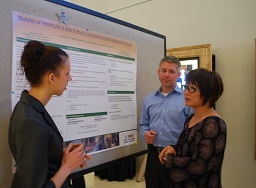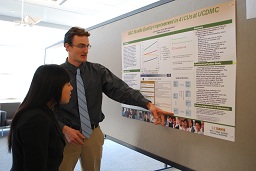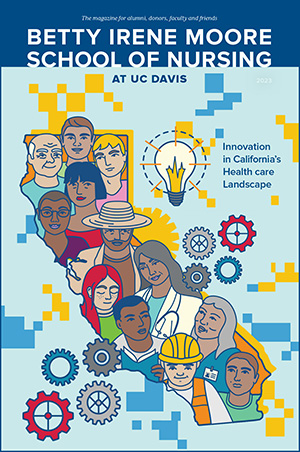Course distinctions: Improving Quality in Health Care
In new course, students learn quality improvement by doing

Master's-degree student Theresa Pak, right, discusses her quality improvement work with project collaborators Joan Daly, a nurse, and Jason Adams, a physician.
Redesigning health-care systems to be safer, more effective and more efficient is complex work that is more fully understood when health-care professionals actually engage with quality improvement efforts in the settings where care is delivered and as part of interprofessional teams.
For that reason, the new Improving Quality in Health course piloted this year at the UC Davis schools of health employs a learn-by-doing approach in which students actively test and analyze ongoing quality improvement interventions in the field.
“You have to be operating in a real, working health-care environment to fully understand what your specific quality improvement challenges are,” said Debra Bakerjian, who co-created the course with Ulfat Shaikh. Bakerjian is an assistant adjunct professor at the Betty Irene Moore School of Nursing and Vice Chair for Family Nurse Practitioner and Physician Assistant Studies at the UC Davis School of Medicine. Shaikh is an associate professor of pediatrics and the director of health-care quality integration in the School of Medicine. She also serves as the clinical quality officer in the California Department of Health Care Services.
In the class, students learn to use systematic approaches to identify quality issues in health care and test ways to improve efficiency, outcomes or patient satisfaction. Early attempts to improve quality in health care looked to change the actions of individual clinicians, according to Shaikh. But those approaches proved inadequate. Now, quality improvement experts focus on implementing complex systems change, which looks at the overall system in place—the environment, organization, culture, relevant players and how all these parts interact.
“For robust quality improvement, we must study current processes, and then fundamentally change the system,” Shaikh said.
Students learn core knowledge about quality improvement methodology and then partner with clinicians to test interventions as part of ongoing quality improvement projects. The course uses an improvement methodology developed by Associates in Process Improvement called “Plan-Do-Study- Act” to test and evaluate the interventions.
In the Plan phase, the project team develops a plan for testing a particular change that may improve quality. In the Do phase, the project team tests the plan on a small scale. In the Study phase, the team examines the effects of the implemented change. In the Act phase, the team determines how the change should be modified or continued based on the results of the intervention.
“We help students learn and understand the process of quality improvement. That process can then be applied to any situation or setting,” Bakerjian said.
The course is purposefully interprofessional—it is open to nursing, medical, public health and health informatics students.

Jeremy Meis, a public health graduate student, describes his quality improvement project at the Integrating Quality Symposium.
Jeremy Meis, a physician assistant and student in the Master of Public Health program at UC Davis, said the interprofessional nature of the course brought a diversity of perspectives into the classroom.
“Each health-care profession has a different way of looking at patient care and their role in it,” Meis said. “Understanding how different professionals view their role is good for patient care and good for our continued development as clinicians.”
According to Bakerjian, quality improvement in health care is based on the concept that no matter what a given process is, it can always be improved. And there is wide agreement that there is room for improvement within health care in the U.S. For example, between 44,000 and 98,000 Americans die in hospitals each year due to preventable health-care errors, according to the 1999 Institute of Medicine report “To Err is Human: Building a Safer Health System.”
The student projects cover a range of health-care topics, such as:
- An intervention to reduce the amount of time patients in intensive-care units spend on ventilators, by better coordinating spontaneous breathing trials, which are conducted by respiratory therapists, with brief breaks from sedation medication, which are coordinated by nurses. The pairing of these two kinds of exercises has been shown to decrease the amount of time individuals spend on ventilators, as well as decrease ventilator-associated pneumonia and the average time ventilated individuals spend in the intensive-care unit. The project team implemented an interprofessional educational program to drive improved coordination of these two types of exercises.
- An educational intervention to teach nurses how to place IV catheters in peripheral veins using ultrasound technology, a procedure not normally done by nurses in intensive-care units. This project specifically examined the efficacy of teaching nurses this skill during a dedicated time when they were not simultaneously responsible for patient care. Peripheral IV catheters—those inserted in an arm, for instance—are associated with lower rates of infections and other kinds of complications than central IV lines, such as those placed in the chest.
- An analysis of how a hospital’s discharge process aligned with best practices regarding patient discharge, to determine if there are areas for improvement that might explain why patients gave relatively low satisfaction scores in relation to the discharge process.
Students said the projects enabled them to wrestle with the complexity of all aspects of quality improvement, from big-picture angles such as how to actually define a problem to seemingly mundane—but critical—challenges such as how to implement an intervention that depends on a variety of health professionals who work different shifts and schedules.
“Quality is an ongoing process,” said Theresa Pak, a student in the class. Pak is a master’s-degree nursing student in the interprofessional Nursing Science and Health-Care Leadership Graduate Degree Program. “Just because you don’t meet your goal doesn’t mean you failed. It’s just another opportunity for improvement.”
The course grew out of student interest, after the interprofessional Quality Improvement Student Interest Group requested additional educational offerings related to quality improvement.
“Having students from a variety of professional backgrounds in this course makes it an enriching experience,” said Rocio Hernandez, a marriage and family therapist who is in the Nursing Science and Health-Care Leadership doctoral program. “I would encourage people in different schools and programs to take the course. I think it will make us better practitioners if we all have a background in what quality improvement looks like.”
As part of the course, all students are required to submit an abstract about their project to UC Davis Health’s annual Integrating Quality Symposium: Linking Clinical and Educational Excellence. The symposium is an opportunity to share innovations and best practices in quality improvement across the UC Davis Health community. Four student groups presented posters of their quality improvement projects as part of the symposium.





